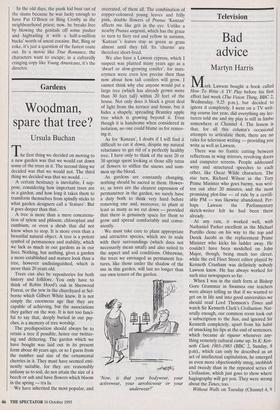Gardens
Woodman, spare that tree?
Ursula Buchan
The first thing we decided on moving to a new garden was that we would cut down some of the trees in it. The second thing we decided was that we would not. The third thing we decided was that we would. . . .
A certain hesitancy is inevitable, I sup- pose, considering how important trees are in a garden, and how long it takes them to transform themselves from spindly sticks to what garden designers call a 'feature'. But it goes deeper than that.
A tree is more than a mere concatena- tion of xylem and phloem, chloroplast and cambium, or even a shrub that did not know when to stop. It is more even than a beautiful natural object. A tree is a potent symbol of permanence and stability, which we lack as much in our gardens as in our lives. Nothing, but nothing, gives a garden a more established and mature look than a tree, however undistinguished, which is more than 20 years old.
Trees can also be repositories for both history and folklore. You only have to think of Robin Hood's oak in Sherwood Forest, or the yew in the churchyard at Sel- borne which Gilbert White knew. It is not simply the enormous age that they are capable of achieving, but the associations they gather on the way. It is not too fanci- ful to say that, deeply buried in our psy- ches, is a memory of tree worship.
The predisposition should always be to retain a tree if possible, hence our twitter- ing and dithering. The garden which we have bought was laid out in its present form about 40 years ago, or so I guess from the number and size of the ornamental cherries in it. They must have seemed emi- nently suitable, for they are reasonably unfussy as to soil, do not attain the size of a beech or ash and have flowers which bloom in the spring — tra la.
We have inherited the most popular, and overrated, of them all. The combination of copper-coloured young leaves and frilly pink, double flowers of Prunus `Kaman' affects me like grit in the eye. Unlike a nearby Prunus sargentii, which has the grace to turn to fiery red and yellow in autumn, `Kanzan"s leaves stay as green as grass almost until they fall. Its 'charms' are therefore short-lived.
We also have a Lawson cypress, which I suspect was planted many years ago as a `dwarf or slow-growing conifer', for nurs- erymen were even less precise then than now about how tall conifers will grow. I cannot think why else anyone would put a large tree (which has already grown more than 30 feet tall) within 20 feet of the house. Not only does it block a great deal of light from the terrace and house, but it hides a shapely, spreading Bramley apple tree which is growing beyond it. Even though it is handsome when considered in isolation, no one could blame us for remov- ing it.
As for `Kaman', I doubt if I will find it difficult to cut it down, despite my natural reluctance to get rid of a perfectly healthy tree. I have only to think of the next 20 or 30 springs spent looking at those silly tutus of flowers to stiffen the sinews and sum- mon up the blood.
As gardens are constantly changing, nothing should be sacred in them. Howev- er, as trees are the clearest expression of permanence in the garden, we surely have a duty both to think very hard before removing one and, moreover, to plant at least as many as we cut down — provided that there is genuinely space for them to grow and spread comfortably and conve- niently.
We must take care to plant appropriate and attractive species, which are in scale with their surroundings (which does not necessarily mean small) and also suited to the aspect and soil conditions. Otherwise, the trees we envisaged as permanent fea- tures, like those under the shadow of the axe in this garden, will last no longer than our own tenure of the garden.
`Now, is that your bodywear, your activewear, your aerobicwear or your underwear?'


























































 Previous page
Previous page